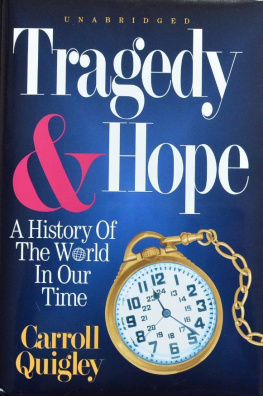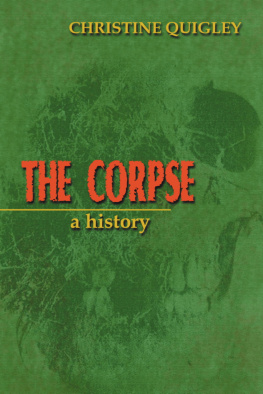Carroll Quigley - Tragedy and Hope: A History of the World in Our Time
Here you can read online Carroll Quigley - Tragedy and Hope: A History of the World in Our Time full text of the book (entire story) in english for free. Download pdf and epub, get meaning, cover and reviews about this ebook. year: 2014, publisher: GSG & Associates Publishers, genre: History. Description of the work, (preface) as well as reviews are available. Best literature library LitArk.com created for fans of good reading and offers a wide selection of genres:
Romance novel
Science fiction
Adventure
Detective
Science
History
Home and family
Prose
Art
Politics
Computer
Non-fiction
Religion
Business
Children
Humor
Choose a favorite category and find really read worthwhile books. Enjoy immersion in the world of imagination, feel the emotions of the characters or learn something new for yourself, make an fascinating discovery.

- Book:Tragedy and Hope: A History of the World in Our Time
- Author:
- Publisher:GSG & Associates Publishers
- Genre:
- Year:2014
- ISBN:094500110
- Rating:4 / 5
- Favourites:Add to favourites
- Your mark:
- 80
- 1
- 2
- 3
- 4
- 5
Tragedy and Hope: A History of the World in Our Time: summary, description and annotation
We offer to read an annotation, description, summary or preface (depends on what the author of the book "Tragedy and Hope: A History of the World in Our Time" wrote himself). If you haven't found the necessary information about the book — write in the comments, we will try to find it.
Tragedy and Hope: A History of the World in Our Time — read online for free the complete book (whole text) full work
Below is the text of the book, divided by pages. System saving the place of the last page read, allows you to conveniently read the book "Tragedy and Hope: A History of the World in Our Time" online for free, without having to search again every time where you left off. Put a bookmark, and you can go to the page where you finished reading at any time.
Font size:
Interval:
Bookmark:
Table of Contents
Preface
I INTRODUCTION: WESTERN CIVILIZATION IN ITS WORLD SETTING
Cultural Evolution in Civilizations
Cultural Diffusion in Western Civilization
Europes Shift to the Twentieth Century
II WESTERN CIVILIZATION TO 1914
The Pattern of Change
European Economic Developments
The United States to 1917
III THE RUSSIAN EMPIRE TO 1917
IV THE BUFFER FRINGE
The Near East to 1914
The British Imperial Crisis: Africa, Ireland, and India to 1926
The Far East to World War I
V THE FIRST WORLD WAR 1914-1918
The Growth of International Tensions, 1871-1914
Military History, 1914-1918
Diplomatic History, 1914-1918
The Home Front, 1914-1918
VI THE VERSAILLES SYSTEM AND THE RETURN TO NORMALCY, 1919-1929
The Peace Settlements, 1919-1923
Security, 1919-1935
Disarmament, 1919-1935
Reparations, 1919-1932
VII FINANCE, COMMERCIAL POLICY, AND BUSINESS ACTIVITY, 1897-1947
Reflation and Inflation, 1897-1925
The Period of Stabilization, 1922-1930
The Period of Deflation, 1927-1936
Reflation and Inflation 1933-1947
VIII INTERNATIONAL SOCIALISM AND THE SOVIET CHALLENGE
The International Socialist Movement
The Bolshevik Revolution to 1924
Stalinism, 1924-1939
IX GERMANY FROM KAISER TO HITLER, 1913-1945
Introduction
The Weimar Republic
The Nazi Regime
X BRITAIN: THE BACKGROUND TO APPEASEMENT, 1900-1939
The Social and Constitutional Background
Political History to 1939
XI CHANGING ECONOMIC PATTERNS
Introduction
Great Britain
Germany
France
The United States of America
The Economic Factors
The Results of Economic Depression
The Pluralist Economy and World Blocs
XII THE POLICY OF APPEASMENT, 1931-1936
Introduction
The Japanese Assault, 1931-1941
The Italian Assault, 1934-1936
Circles and Countercircles, 1935-1939
The Spanish Tragedy, 1931-1939
XIII THE DISRUPTION OF EUROPE, 1937-1939
Austria Infelix, 1933-1938
The Czechoslovak Crisis, 1937-1938
The Year of Dupes, 1939
XIV. WORLD WAR II: THE TIDE OF AGGRESSION, 1939-1941
Introduction
The Battle of Poland, September 1939
The Sitzkrieg, September 1939-May 1940
The Fall of France (May-June 1940) and the Vichy Regime
The Battle of Britain, July-October 1940
The Mediterranean and Eastern Europe, June 1940-June 1941
American Neutrality and Aid to Britain
The Nazi Attack on Soviet Russia, 1941-1942
XV. WORLD WAR II: THE EBB OF AGGRESSION, 1941-1945
The Rising Sun in the Pacific, to 1942
The Turning Tide, 1942-1943: Midway, El Alamein, French Africa, and Stalingrad
Closing in on Germany, 1943-1945
Closing in on Japan, 1943-1945
XVI. THE NEW AGE
Introduction
Rationalization and Science
The Twentieth-Century Pattern
XVII. NUCLEAR RIVALRY AND THE COLD WAR: 1945-1950
The Factors
The Origins of the Cold War, 1945-1949
The Crisis in China, 1945-1950
American Confusions, 1945-1950
XVIII. NUCLEAR RIVALRY AND THE COLD WAR: 1950-1957
Joe I and the American Nuclear Debate, 1949-1954
The Korean War and Its Aftermath, 1950-1954
The Eisenhower Team, 1952-1956
The Rise of Khrushchev, 1953-1958
The Cold War in Eastern and Southern Asia, 1950-1957
XIX. THE NEW ERA 1957-1964
The Growth of Nuclear Stalemate
The Disintegrating Superblocs
The Eclipse of Colonialism
XX. TRAGEDY AND HOPE: THE FUTURE IN PERSPECTIVE
The Unfolding of Time
The United States and the Middle-Class Crisis
European Ambiguities
Conclusion
The powers of financial capitalism had another far-reaching aim, nothing less than to create a world system of financial control in private hands able to dominate the political system of each country and the economy of the world as a whole. This system was to be controlled in a feudalistic fashion by the central banks of the world acting in concert, by secret agreements arrived at in frequent meetings and conferences. The apex of the systems was to be the Bank for International Settlements in Basel, Switzerland, a private bank owned and controlled by the worlds central banks which were themselves private corporations. Each central bank...sought to dominate its government by its ability to control Treasury loans, to manipulate foreign exchanges, to influence the level of economic activity in the country, and to influence co-operative politicians by subsequent economic rewards in the business world.
Carroll Quigley
BY CARROLL QUIGLEY
The Evolution of Civilizations
Tragedy and Hope: A History of the World in Our Time
The Anglo-American Establishment
HOW TO ORDER
Single copies may be ordered from your local book source. Quantity discounts are also available to bookstores, libraries, various
organizations and institutions by contacting
GSG & Associates,
P.O. Box 590, San Pedro, CA 90733,
Phone (310)548-3455/Fax (310)548-5802.
On your letterhead, include information concerning the intended use and the number of books you wish to purchase.
TRAGEDY
AND
HOPE
A History of
THE WORLD
in Our Time
Carroll Quigley
First published in 1966 by
THE MACMILLAN COMPANY, NEW YORK
COLLIER-MACMILLAN LIMITED, LONDON
Copyright Carroll Quigley 1966
All rights reserved. No part of this book
may be reproduced or utilized in any form
or by any means, electronic or mechanical,
including photocopying, recording or by any
information storage and retrieval system,
without permission in writing from the Publisher.
First Printing
The Macmillan Company, New York
Collier-Macmillan Canada, Ltd., Toronto, Ontario
Library of Congress catalog card number: 65-13589
Printed in the United States of America
Second Printing 1974
By Wm. Morrison, Los Angeles, Calif.
With Permission of Carroll Quigley
Third Printing 1998
With Permission of William Morrison
By George S. Gabric
San Pedro, Calif. 90733
ISBN# 0-945001-10-X
Copyright Pending
G S G & ASSOCIATES
Post Office Box 590
San Pedro, California90733
USA
gsgbooks@earthlink.net

ISBN #0-945001-10-X
TO
ALL WHO CARE
AND SEEK TO HELP
Preface
The expression contemporary history is probably self-contradictory, because what is contemporary is not history, and what is history is not contemporary. Sensible historians usually refrain from writing accounts of very recent events because they realize that the source materials for such events, especially the indispensable official documents, are not available and that, even with the documentation which is available, it is very difficult for anyone to obtain the necessary perspective on the events of ones own mature life. But I must clearly not be a sensible or, at least, an ordinary historian, for, having covered, in an earlier book, the whole of human history in a mere 271 pages, I now use more than 1300 pages for the events of a single lifetime. There is a connection here. It will be evident to any attentive reader that I have devoted long years of study and much original research, even where adequate documentation is not available, but it should be equally evident that whatever value this present work has rests on its broad perspective. I have tried to remedy deficiencies of evidence by perspective, not only by projecting the patterns of past history into the present and the future but also by trying to place the events of the present in their total context by examining all the varied aspects of these events, not merely the political and economic, as is so frequently done, but by my efforts to bring into the picture the military, technological, social, and intellectual elements as well.
Next pageFont size:
Interval:
Bookmark:
Similar books «Tragedy and Hope: A History of the World in Our Time»
Look at similar books to Tragedy and Hope: A History of the World in Our Time. We have selected literature similar in name and meaning in the hope of providing readers with more options to find new, interesting, not yet read works.
Discussion, reviews of the book Tragedy and Hope: A History of the World in Our Time and just readers' own opinions. Leave your comments, write what you think about the work, its meaning or the main characters. Specify what exactly you liked and what you didn't like, and why you think so.











